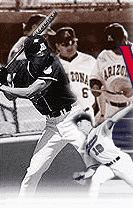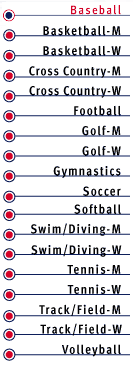
  |


| ... |
11.23.1999 Balanced Attack, Solid Defense Give Cats Hope for More Postseason Play in 2000 Last season, Arizona accomplished one of its goals by returning to postseason play for the first time since 1993. In 2000, the Cats will look to extend their campaign even further into June. With seven starters and virtually the entire pitching staff returning from last season's squad, Arizona can field a balanced offensive attack, a sound defense and deep group of hurlers. The Cats feature three potential All-Americans and members of the 1999 USA Baseball team. Shorstop Keoni DeRenne, right-hander Ben Diggins and right fielder Shelley Duncan were part of the national squad that posted a 24-15 mark. DeRenne was the team's starting shortstop and hit .376 with a remarkable .506 on-base percentage. He drew 32 walks while striking out just 12 times. Diggins served as the club's closer, posting a 2.05 earned-run average in a team-high 16 appearances. He allowed just 10 base hits in 22.0 innings under Arizona pitching coach Bill Kinneberg, who filled the same capacity for Team USA. Duncan batted just 26 times in limited action before joining the Jayhawk League. Yet even after losing just two starters, head coach Jerry Stitt, entering his fourth season as the Cats' head coach and his 22nd on the staff, says very few spots in the lineup are guaranteed. "We have to go with our best defensive lineup," Stitt said. "That means the only two spots that are absolutely solid are Troy Gingrich in center field and Keoni at short. I see Shelley as about a 99 percent sure thing. He probably wouldn't make a good DH, since he can't sit still for two seconds on the bench. He'd drive himself and everyone else crazy. Plus, he's a very good defensive player. He has good instincts and positions himself very well." DeRenne and Duncan, who hit 3-4 in the Arizona lineup at the end of last season, will serve as the cornerstone of the 2000 Wildcat attack. DeRenne (.361-3-54 for UA in 1999), a second-team All-American as a sophomore last year, has been the Cats' starting shortstop since his first day in Tucson. Last February, he became the fastest Arizona player ever to reach 100 career hits on his way to pacing the team in batting, hits, walks and steals. The Cats' starting center fielder and leadoff hitter from a year ago, Gingrich pleasantly surprised Stitt and the club last June when he decided to return in 2000 for his senior season. He will fulfill those rolls again this season, combining with DeRenne to give UA two stolen-base threats in the top third of the order. Gingrich (.329-1-28), who led Arizona in runs scored and on-base percentage in 1999, also finished fourth in the nation in triples. "You just can't get by, especially on our field, without a good center fielder," Stitt said. "With Troy out there, everybody's confident. "There are two guys on our team who the players gravitate towards for leadership--Troy and Keoni. So we always feel more confident with those two guys on the field, not only because of their tremendous defense skills, but because of their leadership qualities. That's a huge plus for us." DeRenne will be joined in the middle of the lineup by Duncan, who hit more home runs last season than any freshman in Pac-10 history. A freshman All-American, Duncan tied for third in the conference in homers and tied for seventh with 68 runs batted in. He set freshman school records for home runs, RBI, extra-base hits, total bases and slugging percentage. However, his 20 four-baggers were four times as many as any other returning Wildcat. Thus, one of the keys to UA's success in 2000 is likely to be getting Duncan enough protection in the heart of the order. That responsibility could largely fall to the Cats' corner infielders, juniors Ernie Durazo (.293-3-34) and Erik Torres (.295-4-38). First baseman Durazo, the most valuable player of the Shenandoah Valley League last summer, posted a .393 on-base percentage in Pac-10 play in '99, but will be looked to for more power this season. As will third baseman Torres, whose numbers fell off a bit last year from his impressive freshman debut in 1998 when he posted a .727 slugging percentage in limited action. "Durazo and Torres are two guys we're counting on for a little more offensive production than we got out of them last season," Stitt said. "Ernie had a good year, but not as good as he's capable of having. He tore it up in the Valley league this summer, hit well in the fall, and we're looking for him to do some great things this spring. "If Erik ever gets it figured out at the plate, he's going to do something really awesome. He really hit the ball well in the fall, for average and power. He's realizing that every time a guy throws a pitch, you're not going to hit it out of the park." Arizona also expects to get more production out of two traditional power spots in the lineup, left field and designated hitter. The Cats will go into January with a number of options at those spots. Last season's starting left fielder, Kenny Huff (.296-3-36), hit .375 with runners in scoring position and tied for second on the team with 14 doubles as a freshman. Keith Regina was a solid contributor as a freshman three years ago, posting a .431 on-base percentage. He returns as a junior with the possibility of joining DeRenne and Gingrich as a third speedster in the lineup. A pair of junior college transfers, Rob Elias and Ryan O'Donnell could work their way into the left field/DH mix as well. Elias, Huff and O'Donnell are all left-handed batters. From the right side of the plate, the Cats could employ freshman Matt Abram, Regina or Diggins, rated the nation's top high school power-hitting prospect in 1998. "I feel confident we're going to get a lot more out of our DH spot this season," Stitt said. "O'Donnell's shown that he can be a impact-type hitter for us. We've got Elias, Jason Shroyer, Regina, Abram. Those are guys with speed and power. We've talked about O'Donnell or Huff playing left and DHing, or Regina playing left against a good lefty. Abrams or Diggins could DH. We have a lot of possibilities. The Cats must replace two starters from a year ago, honorable mention All-Pac-10 second baseman Andy Juday (.288-3-31) and catcher Dennis Anderson (.353-8-42), drafted by the Florida Marlins. DeRenne's middle infield partner is likely to be either sophmore Brad Hassey, who went 4-for-15 in limited play last season and is recovering from a torn ligament in his thumb, or junior college transfer Trevor Mote. "Second base is a toss-up," Stitt said. "Mote's a better offensive player than Hassey. He has a ton of power, but Hassey has the instincts and is a great defensive guy. He's recovered well from his injury and is way ahead of schedule." Behind the plate, the Cats are likely to go with a collection of athletes. Freshman Ken Riley, sophomore Chris Cunningham and possibly even senior Mike Meyer (.355-0-3), drafted in the 14th round by the San Francisco Giants as a pitcher last June, could see action. "We're not worried about our catchers' offensive production," Stitt said. "Our concern is to have the guy back there who does the best job of catching and throwing. Bill and I have rarely seen a guy throw like Riley. He's just a freshman and he'll hit eventually. Cunningham seems to handle all the pitchers really well. He may be a little further along behind the plate right now than Riley." Defensively, the Cats are as solid as they have been in years. Under the tutelage of assistant coach Victory Solis, the 1999 infield of Durazo, Juday, DeRenne and Torres helped Arizona post the sixth-best fielding percentage (.969) in the nation and the Cats' best as a team in 21 years. Durazo's mark of .993 was the best by a Wildcat first baseman since 1983. With three-quarters of the infield and Gingrich back in center field, Arizona's defense should be the least of Stitt's worries this season. "What we've done is eliminate the throwing errors and developed the ability to be in the right place at the right time, both in the infield and the outfield." As is often the case in college baseball, depth on the mound will be key to the Wildcats' success in 2000. The Cats lose No. 1 starter Josh Pearce (7-6, 5.48) from a year ago, but return virtually the entire rest of the staff and plan on adding a couple of healthy returning arms. Ideally, pitching coach Bill Kinneberg would like to be able to use Diggins as he did with Team USA last summer: as the closer. But Arizona will likely need more innings out of the 6-foot-6 sophomore than that role would allow. Diggins (8-6, 6.95) is more likely to end up as the Cats' top starter after striking out better than a batter an inning last year. Diggins will be joining the steady, strike-throwing senior, Michael Crawford (5-5, 6.06) in the rotation. The right-hander set a Wildcat record in 1999 by averaging just 1.54 walks per nine innings. He once faced 84 consecutive batters without issuing a bases on balls last season. But he earned his spot in Arizona history by pitching the game of his life in the Cats' season finale at Arizona State, a complete game, nine strike out, no walk performance in a 6-2 victory over the Sun Devils. The win propelled the Cats into the NCAA Tournament while essentially knocking ASU out. "You know what you're going to get with Crawford," Stitt said. "He'll throw strikes, get outs, be a battler." The third spot is up for grabs. Sophomore lefty Brian Pemble (2-1, 6.32) tied for the team lead in appearances (20) last season, but impressed as a potential starter in the fall. Another southpaw, Nathan Duarte, is a junior college transfer in the running for a spot in the rotation as well. "The guy who pitched better than anybody in the fall was Pemble," Stitt said. "In our minds and the minds of a lot of scouts, there really isn't any ceiling on him. Hitters just don't get good swings off of him, and rarely do they hit the ball hard off of him. "Duarte also pitched really well this fall. He doesn't throw the ball real hard. He gets you out by mixing up his pitches." They'll be joined by a trio of hurlers, right-handers Peter Fredericks and Kevin Huff and lefty Rob Shabansky, who missed the 1999 campaign with injuries. Shabansky (5-1, 3.35 in '98) pitched in just one game for the Cats last season, but could move into the rotation by conference play this year following Tommy John surgery last spring. "Shabansky tells us he's doing fine," Stitt said, "but we keep saying we don't need him until the middle of February. We don't want him to rush it. If he really tries to accelerate his rehab, he might get in trouble. We would be real pleased if he came back in time for conference play. "The two other keys are Fredericks and Huff. They're both throwing off the mound now. Fredericks has the chance to really dominate. If Huff ever returns to his former level, he's going to be real good. He had one of the best sliders we've ever seen. They probably won't be ready until February." Any of those hurlers who do not end up starting will be joined in middle relief by righty Robert Schulz (0-0, 6.23) and, possibly, when he's not catching or playing first, second or third, Meyer. "Everybody says Schulz has the best stuff on the staff," Stitt said. "They say he's nasty. He just needs more experience. He had a great summer, absolutely dominated the Northeastern Collegiate League. Then you've got Meyer who's still our best first baseman, best catcher, probably our second-best second baseman and shortstop. He'll pitch in short relief for us." Stitt and Kinneberg expect to use senior left-hander Tony Milo (3-2, 6.66) as their closer. A seventh-round draft pick of the New York Mets out of high school, Milo may have found his niche in the bullpen. He led the Cats with four saves in 1999, including a critical late-season outing at California when he retired All-American Xavier Nady for the final out with the tying run at third. "Tony fit in real well last year as a closer," Stitt said. "He pitched really well this fall, looked as good as he looked when he first got here out of high school. He's smooth and loose and throwing the ball harder. Wherever we put him, he's going to do well." Though Arizona made an early exit in the postseason last year, the experience the Cats picked up was invaluable, and Stitt is planning on that equating to a more confident ballclub in 2000. "It's important for those guys to know that they have been there, and that they can do it again," Stitt said. "They learned a lot about themselves. They were a little intimidated last year, and realized afterwards that they didn't need to be. They were as good as anyone in there, including Baylor. It's important to have done that and to have made that realization." |
Baseball | Basketball-M | Basketball-W | Cross Country-M | Cross Country-W Football | Golf-M | Golf-W | Gymnastics | Soccer | Softball Swimming/Diving-M | Swimming/Diving-W | Tennis-M | Tennis-W Track & Field-M | Track & Field-W | Volleyball | Staff Directory/General Info Community Service | Donor Relations & Philanthropy | Heritage & Traditions Publications | Special Events | Student-Athlete Services | Trademarks & Licensing Alumni Letterwinners | Other LInks | Arizona.edu | Pac-10 ©Copyright 1999 Total Sports --> and The University of Arizona. All rights reserved worldwide. No portion of this site may be reproduced or duplicated without the express written permission of Total Sports and its third-party content partners. |
|